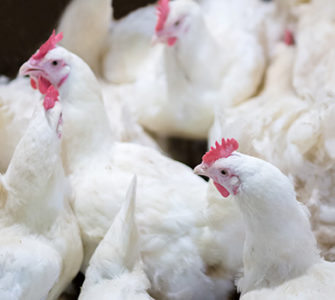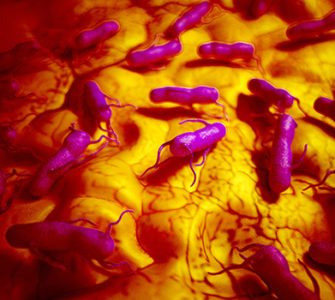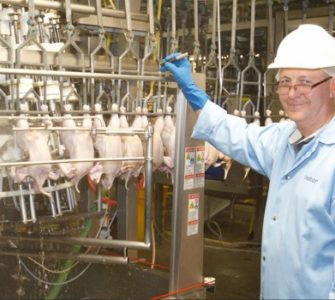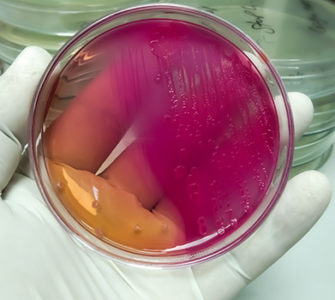Live E. coli, Salmonella vaccines remained effective when used together in challenge study
Administration of a modified-live Escherichia coli vaccine along with a live Salmonella vaccine does not appear to affect the efficacy of either, indicate the results of a recent challenge study.[1]
For the study, the researchers divided specific-pathogen-free layer type chickens into 12 groups. They gave each group of day-old birds either a live E. coli vaccine alone or the E. coli vaccine plus one of two Salmonella vaccines. Some birds were left unvaccinated to serve as controls (Table 1).
The E. coli vaccine used in the study is an 078 strain of the bacterium with the aroA gene deleted to prevent it from causing disease. One of the Salmonella vaccines used helps protect against Salmonella enteritidis (SE) and the other helps protect against S. typhimurium (ST), the researchers said of the study, which was conducted at Animal Health Service in the Netherlands and sponsored by Zoetis.
Investigators sprayed on the E. coli vaccine and orally administered the Salmonella vaccines, said Harm Geerligs, PhD, a scientist with Zoetis, and colleagues.
At 21 days of age, researchers challenged birds from each group with a virulent strain of either 078 E. coli, SE or ST, which they administered to the trachea (Table 1).
Table 1. Study design
| Group | Sham* | Sham* | E. coli vaccine | SE vaccine | ST vaccine | Challenge |
|
1 |
X | X |
E. coli |
|||
|
2 |
X | X |
SE** |
|||
|
3 |
X | X |
ST*** |
|||
|
4 |
X | X |
E. coli |
|||
|
5 |
X | X |
SE |
|||
|
6 |
X | X |
ST |
|||
|
7 |
X | X |
E. coli |
|||
|
8 |
X | X |
SE |
|||
|
9 |
X | X |
E. coli |
|||
|
10 |
X | X |
ST |
|||
|
11 |
X | X |
SE |
|||
| 12 | X | X |
ST |
*Sterile water
**SE = S. enteritidis
***ST = S. typhimurium
The study was blinded so researchers evaluating the results did not know which vaccine regimen the birds had received.
For the next 7 days after challenge, investigators monitored the birds challenged with E. coli for clinical signs of disease and mortality; they also examined and scored for E. coli lesions.
Researchers used one of the following methods to evaluate the birds challenged with Salmonella:
- Analyze cloacal swab samples for the presence of SE or ST on days 3, 5, 7, 10 and 14 days after challenge.
- Check for the presence of Salmonella in the liver on day 7 after challenge, in the liver and spleen 14 days after challenge and in the cecum on days 7 and 14 after challenge.
Based on lesion scores after E. coli challenge, the researchers said there was a statistically significant difference between the vaccinated and unvaccinated groups (Table 2).
Table 2. Lesion scores of chickens 21 days after vaccination with E. coli 078 and 7 days after challenge with a virulent 078 E. coli strain
|
Vaccination groups |
Birds w/ lesions | P value |
Total lesion score |
||||
| Airsacs | Lungs | Hearts | Livers |
Peritoneum |
|||
|
E. coli |
11/30 (37%) | 18 | 16 | ||||
|
E. coli + SE |
13/30 (43%) | 0.793 | 21 | 2 | 11 | 1 |
2 |
|
E. coli + ST |
16/30 (53%) | 0.299 | 35 | 1 | 14 | 1 | |
| Unvaccinated | 22/30 (73%) | 0.009 | 45 | 5 | 31 | ||
The proportion of birds shedding SE after SE challenge did not differ significantly among vaccination groups. Furthermore, the proportion of birds shedding ST after ST challenge was significantly less compared to unvaccinated birds each day after challenge, the researchers reported.
In addition, the percentage of birds with SE or ST present in the liver, spleen and cecum at 7 and 14 days after challenge (Figures 1 and 2) further indicated that efficacy was not affected when the E. coli and a Salmonella vaccine were used together, they said.
“The efficacy of the E. coli vaccine against challenge with the same strain was not affected by either Salmonella vaccine. Conversely, the efficacy of the SE and ST vaccines was not affected by the E. coli vaccine,” they concluded.

Percentage of birds (n = 10) with S. Enteritidis present in liver + spleen and cecum at 7 and 14 days after challenge.

Figure 2. Percentage of birds (n = 10) with ST present in liver + spleen and cecum at 7 and 14 days after challenge.
[1] Data on file. Study report No. B817R-NL-13-307. Zoetis Inc.
Posted on April 6, 2016

















